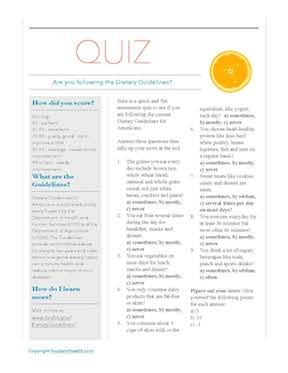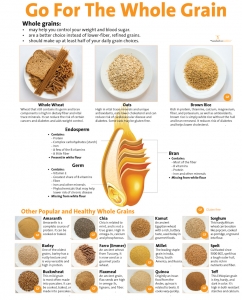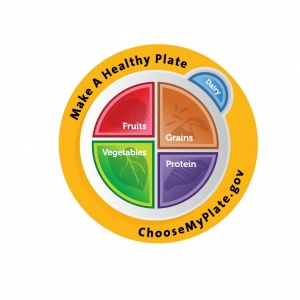Dietary Guidelines News Update
 By now you've probably heard that the Dietary Guidelines Advisory Committee (DGAC) met recently to discuses the upcoming update for the Dietary Guidelines for Americans. But what does this mean for you, a health educator?Let's start with the timeline.This meeting on December 15th was the committee's final session. Though this was their last meeting, the public comment period is still open -- you can send in comments until December 30th. After that, the guidelines will be submitted to the Secretaries of the Departments of Health and Human Services (HHS) and Agriculture (USDA). This should happen in early 2015. After the guidelines have been submitted to those departments, a new comment period will be scheduled, and a date for a public meeting to discuss the guidelines will be set. This information will all come out in 2015 and will be published in a Federal Register notice. According to the guideline timeline, the "DGAC's report [will be] published and made available to public for comment" in winter of 2015. The HHS and USDA will review the report and public comments, then prepare the policy document. If all goes according to plan, the HHS and USDA will publish the Dietary Guidelines for Americans in the fall of 2015.Now let's get to the good stuff! What was reported at the meeting on December 15th?At the meeting, the DGAC heard the findings of all 5 science review subcommittees. These committees were as follows...
By now you've probably heard that the Dietary Guidelines Advisory Committee (DGAC) met recently to discuses the upcoming update for the Dietary Guidelines for Americans. But what does this mean for you, a health educator?Let's start with the timeline.This meeting on December 15th was the committee's final session. Though this was their last meeting, the public comment period is still open -- you can send in comments until December 30th. After that, the guidelines will be submitted to the Secretaries of the Departments of Health and Human Services (HHS) and Agriculture (USDA). This should happen in early 2015. After the guidelines have been submitted to those departments, a new comment period will be scheduled, and a date for a public meeting to discuss the guidelines will be set. This information will all come out in 2015 and will be published in a Federal Register notice. According to the guideline timeline, the "DGAC's report [will be] published and made available to public for comment" in winter of 2015. The HHS and USDA will review the report and public comments, then prepare the policy document. If all goes according to plan, the HHS and USDA will publish the Dietary Guidelines for Americans in the fall of 2015.Now let's get to the good stuff! What was reported at the meeting on December 15th?At the meeting, the DGAC heard the findings of all 5 science review subcommittees. These committees were as follows...
- Subcommittee 1: Food and Nutrient Intakes, and Health: Current Status and Trends
- Subcommittee 2: Dietary Patterns Foods and Nutrients, and Health Outcomes
- Subcommittee 3: Diet and Physical Activity Behavior Change
- Subcommittee 4: Food and Physical Activity Environments
- Subcommittee 5: Food Sustainability and Safety
The meeting also covered two additional topics...
- Cross-Cutting Topics of Public Health Importance
- Physical Activity
To see the full webcast of this meeting, visit the DGAC Meeting 7: Materials and Presentations page.Though this meeting covered much of what will be considered in the final report, it is still just the findings and recommendations of the DGAC. The findings are science-based and have been exhaustively researched. So far, it appears as though what the committee found pretty much supports the previous incarnations of the Dietary Guidelines for Americans and the earlier research of the committee.So, what are the keys for you, as a health educator?I believe the most important findings fall into 3 categories...
- Nutrients and Foods of Concern
- Overconsumed Foods and Food Elements
- The Science Behind the Findings
Let's take a look at each one in more detail.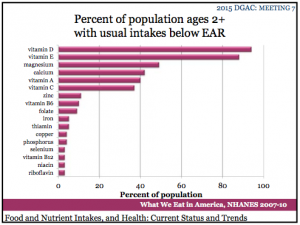 Nutrients and Foods of Concern:The DGAC looked at health outcomes data, nutritional biomarker data, and intake data and found the following deficiencies...
Nutrients and Foods of Concern:The DGAC looked at health outcomes data, nutritional biomarker data, and intake data and found the following deficiencies...
- The entire US population is underconsuming calcium, fiber, potassium, and vitamin D.
- Adolescent and premenopausal woman are not getting enough iron.
Take a look at the chart of the percent of the US population with usual intakes below the Estimated Average Requirement (EAR). This slide comes directly from the DGAC meeting on December 15th. Vitamin D is of particular concern -- the statistics are quite shocking!Where are these deficiencies coming from? Well, the committee asserts that "Across all age and sex groups, the vast majority of the U.S. population does not meet recommended intakes for fruit, vegetables, whole grains, and dairy food groups."Looking at the trends over time, the DGAC has revealed that fruit and dairy consumption have remained low but stable, while vegetable consumption has actually declined since it was last explored. Whole grains are perhaps the most interesting, because whole grain intake has increased but still remains low overall, while refined grain intake has decreased yet still remains too high overall.Many of the nutrients from healthful foods are being displaced by empty calories from less healthful options, which brings us to the second section: overconsumed foods and food elements.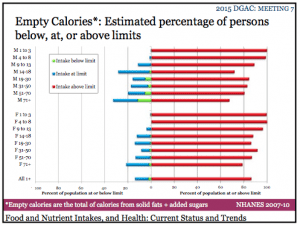 Overconsumed Food and Food Elements:Using the same health outcomes data, nutritional biomarker data, and intake data, the DGAC discovered...
Overconsumed Food and Food Elements:Using the same health outcomes data, nutritional biomarker data, and intake data, the DGAC discovered...
- The entire US population is overconsuming sodium.
- People are overconsuming saturated fat and may pose especially great risk to people over the age of 50.
- Cholesterol is "not considered a nutrient of concern for overconsumption."
The report further reveals that "Across all age and sex groups, the vast majority of the U.S. population exceeds recommended intakes of refined grains, solid fats, and added sugars."Let's take a moment to focus on added sugars, since the most recent meeting of the DGAC explored several aspects of American sugar intake.To start, snacks and sweets provide much of the added sugars and solid fats consumed in the US. Beverages take the lead with added sugars, however, offering almost half of all the sugars consumed daily by Americans. Though consumption of added sugars has decreased in the past few years, it is still far above the limits recommended by the USDA.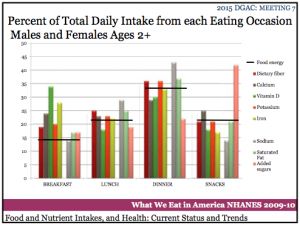 Perhaps the resource that sheds the most light on over- and underconsumed foods is this slide from the most recent meeting. It explores the percent of total daily intake of fiber, calcium, vitamin D, potassium, iron, sodium, saturated fat, and added sugars from each eating occasion. What do you notice?Oh, and before we move away from this section, I want to offer a bit of insight from James J. Kenney, PhD and FACN. After perusing the guidelines, Dr. Jay wrote..."They do advocate a plant-based diet and lower saturated fat intake but are not worried about cholesterol. We should take care to lower intake of high cholesterol foods. It does raise LDL or bad cholesterol. The main reason to eat less shrimp, calamari, and eggs is because of their high cholesterol content. You can reduce the saturated fat content of meat and poultry (at least parts of them can be pretty low in saturated fat) but the cholesterol content can not be significantly reduced. With dairy if you skim off the fat you get rid of nearly all the cholesterol too."That's just something to consider as you review the findings of the DGAC for yourself. Now let's move on to the science of the DGAC.
Perhaps the resource that sheds the most light on over- and underconsumed foods is this slide from the most recent meeting. It explores the percent of total daily intake of fiber, calcium, vitamin D, potassium, iron, sodium, saturated fat, and added sugars from each eating occasion. What do you notice?Oh, and before we move away from this section, I want to offer a bit of insight from James J. Kenney, PhD and FACN. After perusing the guidelines, Dr. Jay wrote..."They do advocate a plant-based diet and lower saturated fat intake but are not worried about cholesterol. We should take care to lower intake of high cholesterol foods. It does raise LDL or bad cholesterol. The main reason to eat less shrimp, calamari, and eggs is because of their high cholesterol content. You can reduce the saturated fat content of meat and poultry (at least parts of them can be pretty low in saturated fat) but the cholesterol content can not be significantly reduced. With dairy if you skim off the fat you get rid of nearly all the cholesterol too."That's just something to consider as you review the findings of the DGAC for yourself. Now let's move on to the science of the DGAC.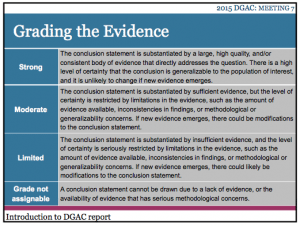 The Science Behind the Findings:So why should your clients take these preliminary findings to heart? It all comes down to good science.The evidence put forward by the committee is based on...
The Science Behind the Findings:So why should your clients take these preliminary findings to heart? It all comes down to good science.The evidence put forward by the committee is based on...
- NEL systematic reviews
- Existing reports
- Existing high-quality evidence-based reports
- Existing systematic reviews
- Existing meta-analyses
- Data analyses
- Food pattern modeling analyses
- Public comments
- Dietary Guidelines Control Center: Index of Resources
- Timeline for the Dietary Guidelines for Americans, 2015 Edition
- Read or Submit Public Comments for the Dietary Guidelines for Americans
- Webcast of the Entire 7th DGAC Meeting on December 15th, 2014
- Dietary Guidelines 2015 Q and A Pages
- Dietary Guidelines Related Resources
Nutrition and Health Education Resources:Want to start teaching your clients about the keys put forward by the DGAC? Check out these educational materials...
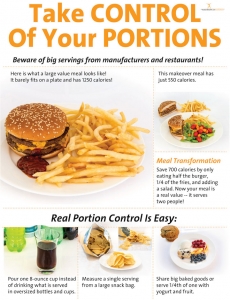
Free Handout:News this big wouldn't be complete without a helpful handout for your clients! Check out this quiz handout everyone can use to see if they are following the current Dietary Guidelines: